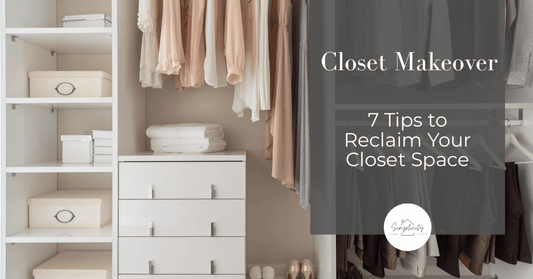If you've ever tried to declutter a playroom from the millions of toys and hearing “But I NEED that!”—you know decluttering with kids can feel like a losing battle. But the good news is: it doesn’t have to be.
Involving your children in the decluttering process isn’t just about a cleaner house—it’s about teaching life-long skills like decision-making, gratitude, and letting go. And yes, you can do it without power struggles or tears.
Here’s how to get your kids involved in decluttering—gently, positively, and with way fewer meltdowns.
1. Start With Your Own Things
Before you touch your child’s toys or clothes, show them what decluttering looks like by doing your own first.
Why it works: Kids learn by example. When they see you donating clothes or letting go of unused items without drama, they’ll understand it’s a normal and positive process—not a punishment.
Try saying: “I haven’t worn this in a while, so I’m donating it to someone who can use it.”
2. Create a Simple Sorting Game

Turn decluttering into a visual and hands-on experience. Set up three bins labeled:
- Keep
- Donate
- Toss (for broken or unusable items)
Let your child help decorate the bins or boxes with drawings or stickers. Then, give them one small area at a time—like a single drawer or toy shelf—to sort through together.
Why it works: Visual organization helps kids understand the process. Plus, making it a “game” adds fun to what could otherwise feel like work.
3. Ask Empowering, Open-Ended Questions
Instead of asking “Do you want to keep this?” (which will almost always get a “yes”), guide your child with thoughtful, simple questions:
- “Do you still play with this?”
- “Would you choose this toy today if you saw it in a store?”
- “Is this something we could give to another child who needs toys?”
Why it works: These types of questions help kids reflect, make decisions, and feel in control—without feeling forced.
4. Set Gentle Boundaries and Limits

Help your kids understand that space is limited. Set boundaries by creating designated bins or shelves—and when they’re full, it’s time to make choices.
Try this: One toy bin per category (blocks, dolls, vehicles). When it’s overflowing, ask your child to choose a few things to donate so everything fits neatly again.
Why it works: Physical limits make decisions easier and help kids learn to edit rather than hoard.
5. Choose the Right Time
Timing matters. A tired or overstimulated child is more likely to melt down than cooperate.
Best times to declutter with kids:
- After a nap or snack
- On a quiet weekend morning
- During a “room reset” before or after play
Why it works: Just like adults, kids make better decisions when they feel calm, fed, and focused.
6. Celebrate Their Effort
Decluttering is a skill—and a success worth celebrating. Praise your child for helping, even if they only let go of one toy. Use before-and-after photos to show progress or offer a simple reward like extra playtime or a special snack.
Try this: “Look how tidy your shelf is now! Great job making space for your favorite things.”
Why it works: Positive reinforcement builds confidence and encourages them to participate again in the future.
Final Thoughts: Simplicity Is a Skill

Decluttering with kids might not look perfect—but it doesn’t have to. The goal isn’t just fewer toys on the floor. It’s creating a calmer home and helping your child build a healthy relationship with “stuff.”
Start small, stay consistent, and keep the process positive. You’ll be amazed how capable kids are when we give them the tools—and a little grace—to learn.










